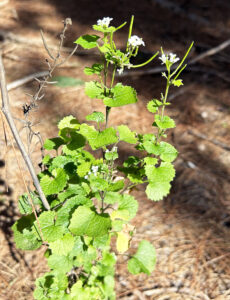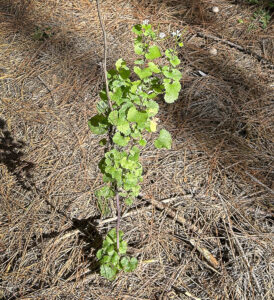
Have you seen an unusual case of garlic mustard flowering twice in the same season? If so, please send a report to invasive.species@wisconsin.gov. / Photo Credit: Frederick Hengst, Wisconsin DNR
By Mary Bartkowiak, DNR Invasive Plant Program Coordinator, Rhinelander
Mary.Bartkowiak@wisconsin.gov or 715-493-0920
and Erika Segerson-Mueller, DNR Invasive Plant Program Specialist, Oshkosh
Erika.SegersonMueller@wisconsin.gov or 715-492-0391
Typically a biennial plant, garlic mustard blooms in the spring. So, it sounds crazy to find the plant blooming again in October.
Although garlic mustard might be taking advantage of an extended growing season, this second bloom also may be cause for concern — or, at least, careful monitoring.
Wisconsin Department of Natural Resources Tax Law Forestry Specialist Frederick Hengst discovered this “mutant” specimen in early October while on a landowner visit near Wild Rose. The plant appears to have flowered and set seed several months earlier, but then re-flowered on the same stem.

If you spot an unusual case of garlic mustard flowering twice in the same season, please send a report to invasive.species@wisconsin.gov. / Photo Credit: Frederick Hengst, Wisconsin DNR
Some suggest that garlic mustard could be morphing into an annual, producing a basal rosette of leaves in the spring and then bolting with flowers in the late summer. The usually observed biennial cycle of garlic mustard consists of a basal rosette in the first year, followed by the plant bolting (sending up a flowering stem) in the second year after one cold season.
More observation and monitoring will take place to see if this second flowering occurrence or shortened annual life cycle is a fluke, or if a pattern can be identified.
If you notice garlic mustard in bloom this fall, please report your find to the DNR’s invasive plant team. Be sure to include photos, the date the plant was found and a GPS point, as well as a description of the land (public or private). Send this information to Invasive.Species@wisconsin.gov. Also, please let us know if you have found more than one plant in flower at the same location.
